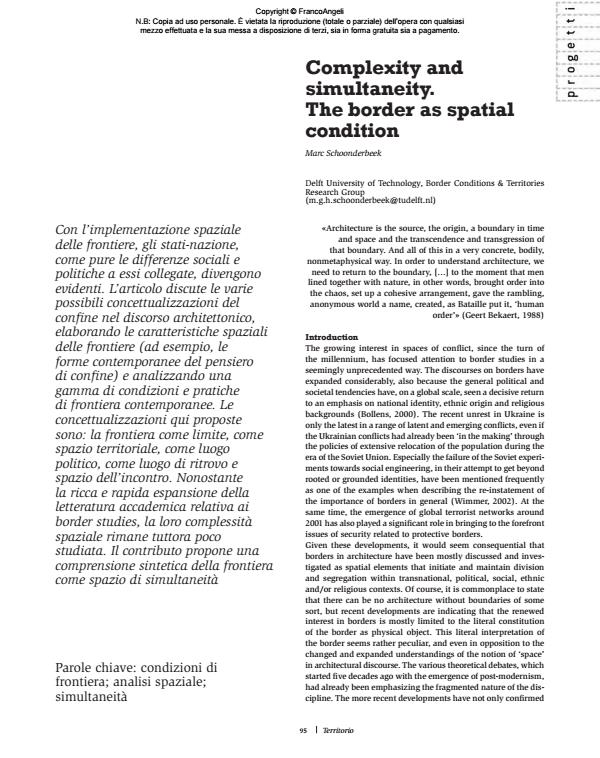Complexity and simultaneity. The border as spatial condition
Titolo Rivista TERRITORIO
Autori/Curatori Marc Schoonderbeek
Anno di pubblicazione 2015 Fascicolo 2015/72 Lingua Inglese
Numero pagine 6 P. 95-100 Dimensione file 252 KB
DOI 10.3280/TR2015-072015
Il DOI è il codice a barre della proprietà intellettuale: per saperne di più
clicca qui
Qui sotto puoi vedere in anteprima la prima pagina di questo articolo.
Se questo articolo ti interessa, lo puoi acquistare (e scaricare in formato pdf) seguendo le facili indicazioni per acquistare il download credit. Acquista Download Credits per scaricare questo Articolo in formato PDF

FrancoAngeli è membro della Publishers International Linking Association, Inc (PILA)associazione indipendente e non profit per facilitare (attraverso i servizi tecnologici implementati da CrossRef.org) l’accesso degli studiosi ai contenuti digitali nelle pubblicazioni professionali e scientifiche
Con l’implementazione spaziale delle frontiere, gli stati-nazione, come pure le differenze sociali e politiche a essi collegate, divengono evidenti. L’articolo discute le varie possibili concettualizzazioni del confine nel discorso architettonico, elaborando le caratteristiche spaziali delle frontiere (ad esempio, le forme contemporanee del pensiero di confine) e analizzando una gamma di condizioni e pratiche di frontiera contemporanee. Le concettualizzazioni qui proposte sono: la frontiera come limite, come spazio territoriale, come luogo politico, come luogo di ritrovo e spazio dell’incontro. Nonostante la ricca e rapida espansione della letteratura accademica relativa ai border studies, la loro complessità spaziale rimane tuttora poco studiata. Il contributo propone una comprensione sintetica della frontiera come spazio di simultaneità
Keywords:Condizioni di frontiera; analisi spaziale; simultaneità
- Bekaert G., 1988, Architecture Devoid of Shadow, 010 Publishers, Rotterdam.
- Bollens S.A., 2000, On Narrow Ground; Urban Policy and Ethnic Conflict in Jerusalem and Belfast, State University of New York Press, Albany/New York.
- Borges B.L., 1949, El Aleph, Editorial Losada, Buenos Aires (engl. trans., 1971, The Aleph and Other Stories: 1933-1969, Bantham Books, New York).
- Bouvy K., 2002, Niemandsland; Berlijn zonder de muur/Berlin ohne die Mauer, De Verbeelding Publishing, Amsterdam.
- Calame J., Charlesworth E., 2009, Divided Cities; Belfast, Beirut, Jerusalem, Mostar, and Nicosia, University of Pennsylvania Press, Philadelphia.
- Chora, Bunschoten R., Hishino T., Binet H., 2001, Urban Flotsam; Stirring the City, 010 Publishers, Rotterdam.
- Cosgrove D., 1990, Mappings, Reaktion Books, London.
- Cupers K., Miessen M., 2002, Spaces of Uncertainty, Verlag Muller and Busmann, Wuppertal.
- Easterling K., 2005, Enduring Innocence; Global Architecture and its Political Masquerades, The Mit Press, Cambridge/London.
- Foucault M., 2007, Security, Territory, Population; Lectures at the Collège de France, 1977-1978 Palgrave MacMillan, New York.
- Glasson Deschaumes G., Iveković R., eds., 2003, Divided Countries, Separated Cities; The Modern Legacy of Partition, Oxford U.P., Oxford/New York.
- Heidegger M., 1951, Building, Dwelling, Thinking (translated in Leach N., ed., 1997, Rethinking Architecture: A Reader in Cultural Theory, Rourtledge, London/New York).
- Krickus R. J., 2002, The Kaliningrad Question, Rowman & Littlefield Publishers, Lanham.
- Kwinter S., 1992, «Landscapes of Change: Boccioni’s ‘Stati d’animo’ as a General Theory of Models», Assemblage, n. 19, pp. 50-65.
- Latour B., Hermant E., 1998, Paris ville invisible, La Découverte-Les Empêcheurs de penser en rond, Paris.
- Multiplicity, Boeri S. et.al., 2003, Uncertain States of Europe; A Trip through a changing Europe, Skira, Milano.
- Mumford L., 1961/1989, The City in History; Its Origins, Its Transformations, and its Prospects, Harcourt, New York.
- Nightingale C.H., 2012, Segregation; A Global History of Divided Cities,
- The University of Chicago Press, Chicago/London. Parker N., Vaughan-Williams N. et al., 2009, «Lines in the Sand?; Towards an Agenda for Critical Border Studies», Geopolitics, vol. 14, n. 3, pp. 582-587. DOI: 10.1080/14650040903081297
- Picon A., Ponte A., eds., 2003, Architecture and the Sciences; Exchanging Metaphors, Princeton Architectural Press, New York.
- Rose B., 2005, The Lost Border; The Landscape of the Iron Curtain, Princeton Architectural Press, New York.
- Rykwert J., 1976, The Idea of a Town; the Anthropology of Urban Form in Rome, Italy and the Ancient World, The Mit Press, Cambridge/London.
- Scholar R., ed., 2006, Divided Cities, Oxford U.P., Oxford.
- Schoonderbeek M., ed., 2010, Border Conditions, Architectura & Natura Press, Amsterdam.
- Shapiro M.J., Alker H.R., eds., 1995, Challenging Boundaries: Global Flows, Territorial Identities, University of Minnesota Press, Minneapolis/London.
- Taylor D., 2010, Working the Line, Radius Books, Santa Fe.
- Vidler A., 2000, Warped Space; Art, Architecture, and Anxiety in Modern Culture, The Mit Press, Cambridge/London.
- Virilio P., 2006, Speed and Politics; An Essay on Dromology, Semiotext(e), Los Angeles (ed. or., 1977, Vitesse et Politique, Édition Galilée, Paris).
- Virilio P., 2005, Desert Screen; War at the Speed of Light, Continuum, London/New York (ed. or., 1991, L’Ecran du Desert, Édition Galilée, Paris).
- Wimmer A., 2002, Nationalist Exclusion and Ethnic Conflict; Shadows of Modernity, Cambridge U.P., Cambridge.
- Spatial Appropriations Over Europe’s Borderland: El Principe’s Growth as a Vestige of Colonial Urbanism Mari Paz Agundez, in Urban Planning 6942/2024
DOI: 10.17645/up.6942
Marc Schoonderbeek, Complexity and simultaneity. The border as spatial condition in "TERRITORIO" 72/2015, pp 95-100, DOI: 10.3280/TR2015-072015